The Ski Resorts of The Sellaronda
The Sellaronda is a circuit of ski lifts and slopes in the Italian Dolomites which connects the ski areas of Val Gardena, Alta Badia, Arabba-Marmolada and Val di Fassa, forming a huge mega area.
These four ski areas contain hundreds of pistes and more than a dozen villages, including famous ski resorts like Selva, Corvara and Arabba, so there is an almost bewildering choice of where to ski and stay.
William Micklethwait, the editor of Ultimate-Ski, picks out the best ski resorts and slopes on the Sellaronda, as well as answering practical questions, like what lift pass will you need; how snow sure is the Sellaronda; can you ski all the way around it; when should you come on a ski holiday to the Sellaronda; and why do many of its resorts have more than one name.
What is The Sellaronda?
The Sellaronda, sometimes spelt “Sella Ronda”, is a giant two-way roundabout for skiers, composed of lifts and pistes that encircles the Sella Massif in the Italian Dolomites. It crosses four mountain passes (Gardena, Sella, Pordoi and Campolongo) and links four otherwise separate ski areas (Val Gardena, Alta Badia, Arabba-Marmolada and Val di Fassa) so you can ski between them.
This means the Sellaronda is neither a ski resort nor a ski area defined by the limits of a lift pass: instead it’s a ski circuit that skiers can use to get from one ski area to three others on skis; or to go around in a huge circle, in either a clockwise or anti-clockwise direction, preferably stopping along the way to eat in amazing mountain restaurants amid spectacular Alpine scenery.
How big is the Sellaronda?
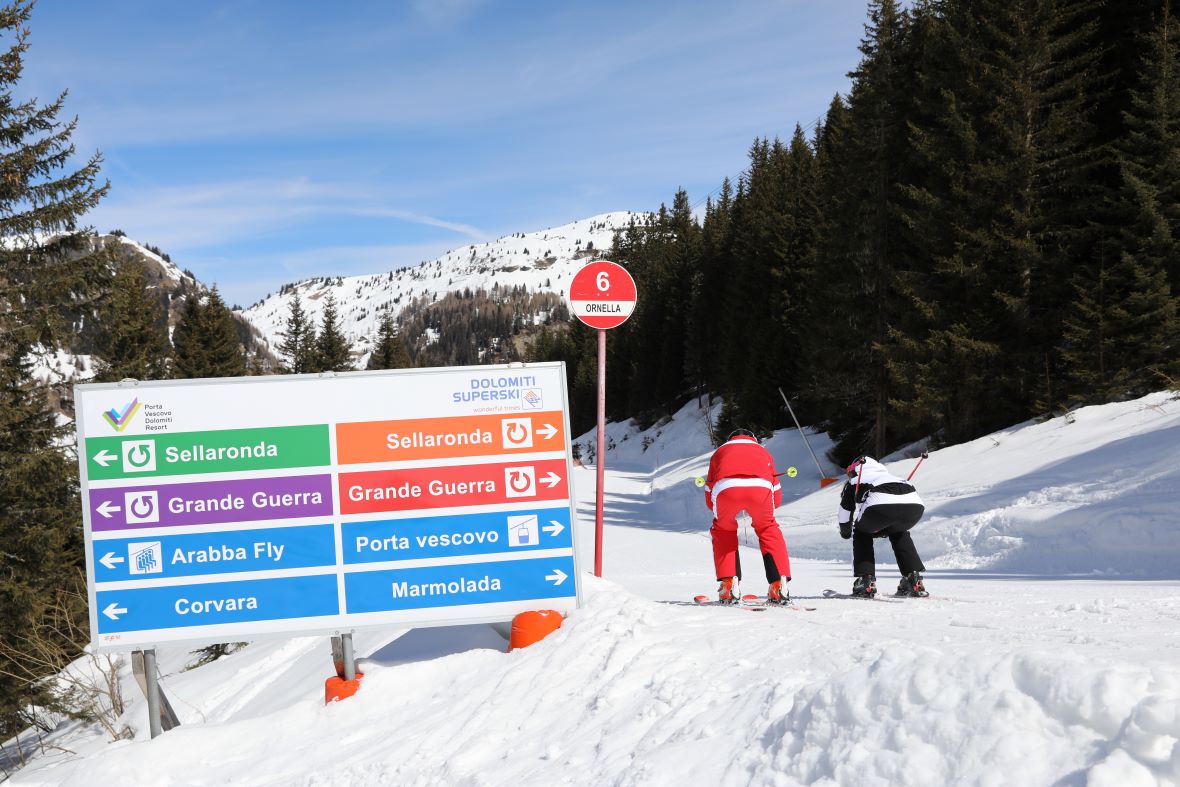
The Sellaronda circuits in Arabba Marmolada ©Arabba_Fodom_Turismo
The Sellaronda circuit itself is about 40km long (25 miles) of which just over 25km (15 miles) is piste, and the remaining 15km (9.5 miles) is spanned by lifts.
The combined total ski area of all the ski resorts linked to the Sellaronda adds up to about 500km (310 miles) of ski slopes, divided into about 400 separate runs, accessed by over 200 ski lifts. This is far more than any normal recreational skier can ski in a week or even a fortnight.
The Sellaronda is therefore one of the world’s largest lift-linked ski areas and comparable in size to the Franco-Swiss Portes du Soleil.
How long does it take to ski around the Sellaronda?
It’s best to allow a full day, although if you are a reasonably competent skier, don’t take any breaks, have no serious falls and avoid long lift queues, you should be able to complete the circuit in under three and half hours, of which about 90 minutes will be spent skiing downhill and the remainder on lifts or waiting for them.
The reason why a three and half hour round trip ends up taking a full day is that to make the Sellaronda circuit enjoyable, you will probably want to allow extra time for lunch, drinks, rest breaks, photo stops and repeating the runs you like best. Plus you need a contingency for bad lift queues (which you might well encounter if you’re skiing the Sellaronda on a weekend or in peak holiday season) and for recovery time in case someone in your group has a fall.
So as a rule of thumb, try to start skiing the circuit by 10am. This shouldn’t be a problem if you’re staying in a resort that’s actually on the Sella Ronda, like Selva, Corvara, Cofosco or Arabba, but might require some planning ahead if you’re staying in a resort away from the circuit, such as Ortisei in Val Gardena or San Cassiano in Alta Badia.
If you fail to get home before the lifts close, there is a road circuit next to the pistes and lifts, but there is no regular bus service along it connecting the four different ski areas, so you will probably have to complete the journey in an expensive taxi.
Is skiing all the way around the Sellaronda worth doing?
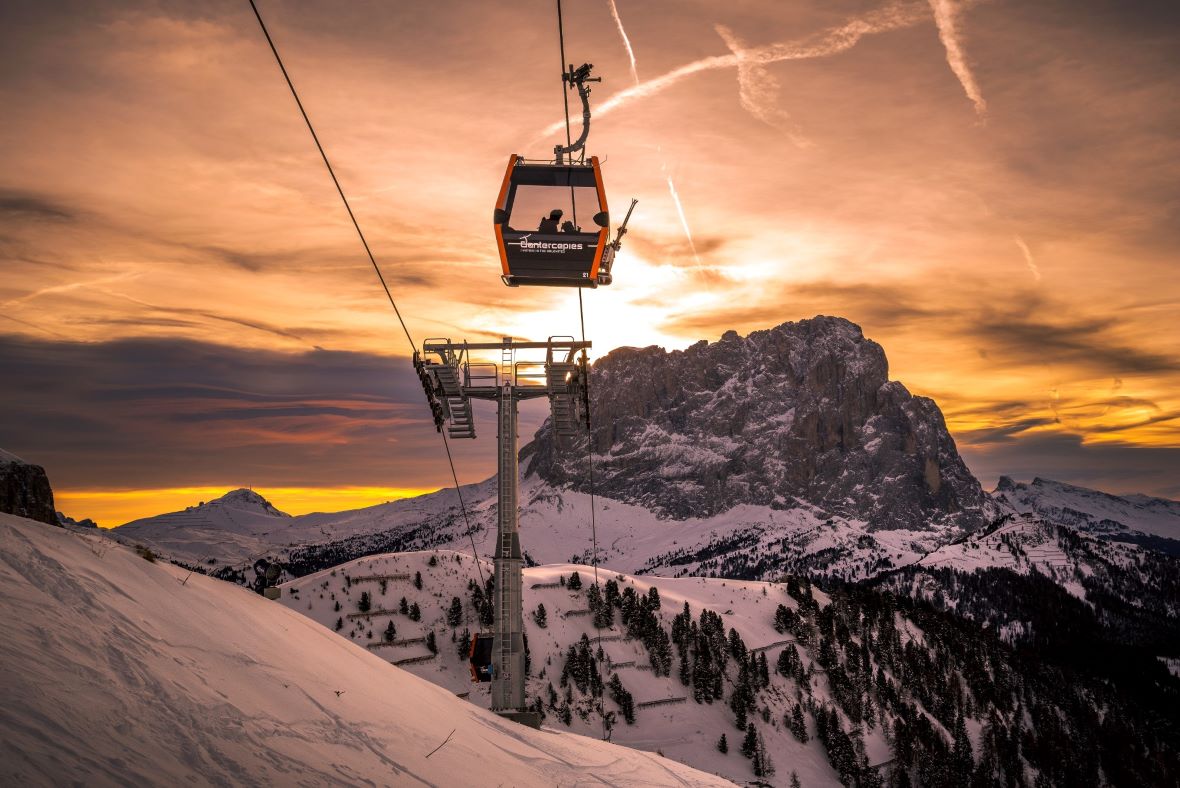
Skiing the Sellaronda means taking a lot of lifts but the views are magnificent ©DOLOMITESValGardena
For some, skiing the full circuit is the highlight of a ski holiday to one of the Sellaronda ski resorts, partly for the sense of achievement of skiing so far in a single day, and partly for the ever changing spectacular scenery.
But for others, the best and least crowded ski slopes tend to be in the hinterlands away from both circuits. So rather than using the Sellaronda simply to go around in a big circle, they prefer to use it to ski from one ski area to another (for example, skiing from Alta Badia into either Val Gardena or Arabba), and spending as much time as possible there away from the main Sellaronda routes before returning.
Which Sellaronda circuit is best: clockwise or anticlockwise?
The Sellaronda is a two-way circuit, so it can be skied clockwise (the ‘orange route’ with orange piste signs) or anticlockwise (the ‘green route’ ).
The clockwise orange loop has fewer lifts (currently 16) and a greater variety of slopes than the green anti-clockwise loop (17 lifts), so it’s usually more enjoyable for confident skiers. It also takes less time if there are no lift queues.
But a lot of skiers know this, so the counter-clockwise green route tends to have shorter lift queues at weekends and peak holiday periods. And this green route is also easier for less confident skiers.
Do you need to be a good skier to ski around the Sellaronda?
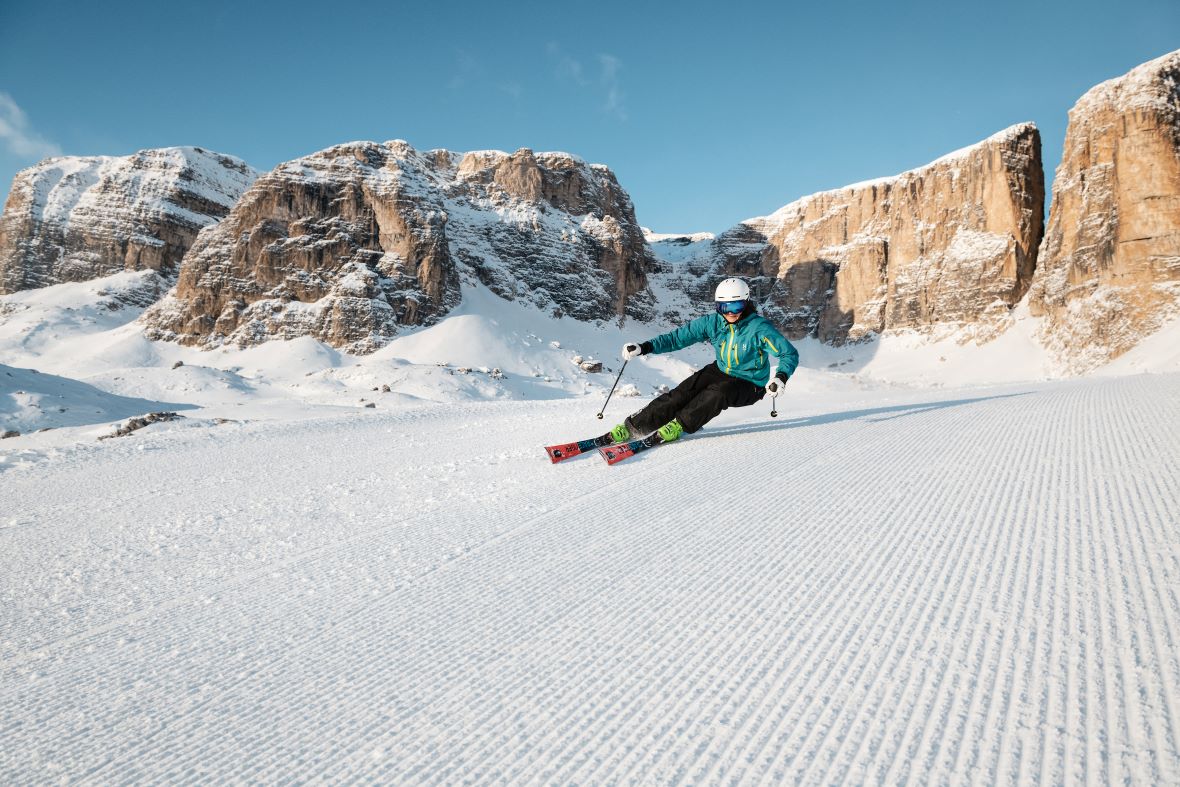
Most of the Sellaronda slopes are easy groomed runs © Alta Badia _ IDM Suedtirol – Alex Moling
To complete the Sellaronda circuit, you have to be an intermediate-level skier capable of skiing a red run. There are only a few mandatory reds on both loops (the steepest are around Arabba on the clockwise circuit) and by red run standards they are relatively mild but they have been graded red rather than blue for a reason.
This doesn’t mean that the Sellaronda ski resorts are unsuitable for beginners, in fact, quite the opposite: Colfosco and Corvara in Alta Badia are among the best ski resorts in the Alps for beginners learning to ski.
What lift pass do you need for the Sellaronda?
All the ski areas connected by the Sellaronda are covered by the Dolomiti Superski pass. This also covers virtually every other ski resort in the Italian Dolomites, including the ones closest to the Sellaronda, such as Cortina d’Ampezzo, Kronplatz and Ski Civetta
You can also get local area passes which cover just one of the four ski areas. These will save you a little bit of money but not much (on average around 20%) considering how many extra slopes and lifts you miss out on. These local area passes can be the best choice, however, if you’re a novice or a nervous skier, or only coming to the Sellaronda for a short break.
Why do a lot of the ski resorts have more than one name?
The Sellaronda is in a tri-lingual part of Italy, the South Tyrol (“Südtirol”), where some villages have always spoken the ancient Ladin language, and which was also part of the German-speaking Habsburg empire until 1918.
Non-Italian names are particularly common in Val Gardena which many locals still call Gröden (German) or Gherdëina (Ladin), and its largest resort, Selva, is also known as Wolkenstein. Similarly Colfosco in Alta Badia is also called Kolfuschg.
For skiers the most obvious practical consequence is that if you drive to a ski resort, the name of the village on your Satnav may not be the same as the one on the piste map, especially if you’ve hired your car in a German-speaking country.
You will also notice that restaurants typically offer three kinds of dishes – local/Ladin, Tyrolean/Austrian and Italian – which means you get a much greater variety of food than in other ski areas, and is one reason why the Sellaronda is almost as famous for its gourmet food as its skiing.
Is Cortina d’Amprezzo part of the Sellaronda?
Cortina d’Amprezzo, Italy’s most glamorous ski resort, is not regarded as part of the Sellaronda but its outer slopes at Cinque Torri are a short taxi ride from Alta Badia, and can also be reached from Arabba via the Grande Guerra circuit (see below). One of Cortina’s lifts in this sector at Passo Falzarego is actually covered by the Alta Badia lifts pass because the Lagazuoi-Armentarola run from the top finishes in Alta Badia.
The rest of Cortina’s lifts are covered by the Dolomiti Superski pass, so if you are staying in Alta Badia or near to it, it’s relatively easy to make day-trips from the Sellaronda into the Cortina d’Amprezzo ski area.
What is the First World War/Grande Guerra Ski Tour?
The area around the Sellaronda saw fierce fighting in the First World War and this has inspired another circuit that can be skied in a day that connects Arabba-Marmolada, Ski Civetta, Cortina d’Ampezzo and Alta Badia.
The First World War Ski Tour is signposted with ‘Grande Guerra’ piste markers. Like the Sellaronda, it’s a 2-way circuit with different coloured signs (purple for the clockwise Grande Guerra route, and red for the anti-clockwise route) and it is covered by the Dolomiti Superski lift pass. But unlike the Sellaronda, the First World War Ski Tour is not entirely lift-linked, so you have to travel from Arabba-Marmolada to Ski Civetta and from Ski Civetta to Cortina d’Ampezzo by bus. The buses are not free but they are inexpensive and frequent.
How reliable is the snow on the Sellaronda?
The Sellaronda route is usually skiable from early December to the first Sunday in April but if warm conditions persist, some of the ski slopes away from the main circuit either close or become unenjoyable to ski, especially lower south-facing runs.
In contrast the Marmolada glacier in Arabba, which is very high (its top lift reaches 3,269m) and north-facing, is reliably snow sure throughout the winter season
It’s also important to appreciate where the Sellaronda’s snow comes from. On Marmolada, the snow may be natural, but on the main Sellaronda routes, that’s rarely the case, because the resorts are some of the biggest users of artificial snow in Europe.
This dependence on artificial snow is due to the Sellaronda’s location in the Italian Dolomites at the south-eastern end of the Alps. As most of the heaviest snowstorms blow in from the north and west, the Sellaronda ski resorts don’t get as much natural snow as their Swiss, French and Austrian counterparts. They also tend to get more sunshine – around 300 sunny days a year.
But whilst the Sellaronda is not naturally snowy, it has quite a high base elevation. The lowest points on the circuit are the villages it passes through, and they can all be considered high-altitude ski resorts: Colfosco is at 1,645m above sea level, Arabba at 1,602m; Corvara at 1,568m; and Selva at 1,563m. And this high base elevation means temperatures at night are cold enough to create the artificial snow the Sellaronda needs.
When should you ski in the Sellaronda?
Pre-Christmas ski holidays to the Sellaronda
The Sellaronda ski resorts typically open in early December. The Audi FIS Ski World Cup Alta Badia and Val Gardena/Gröden races take place before Christmas, which is a very public vote of confidence in the Sella Ronda’s early season snow conditions. In the run-up to the main events, you should expect some slopes to be closed for training or racing, and the resorts to gradually get more crowded. The races are quite a spectacle to witness, particularly if a local boy does well.
Christmas, New Year and January ski holidays to the Sellaronda
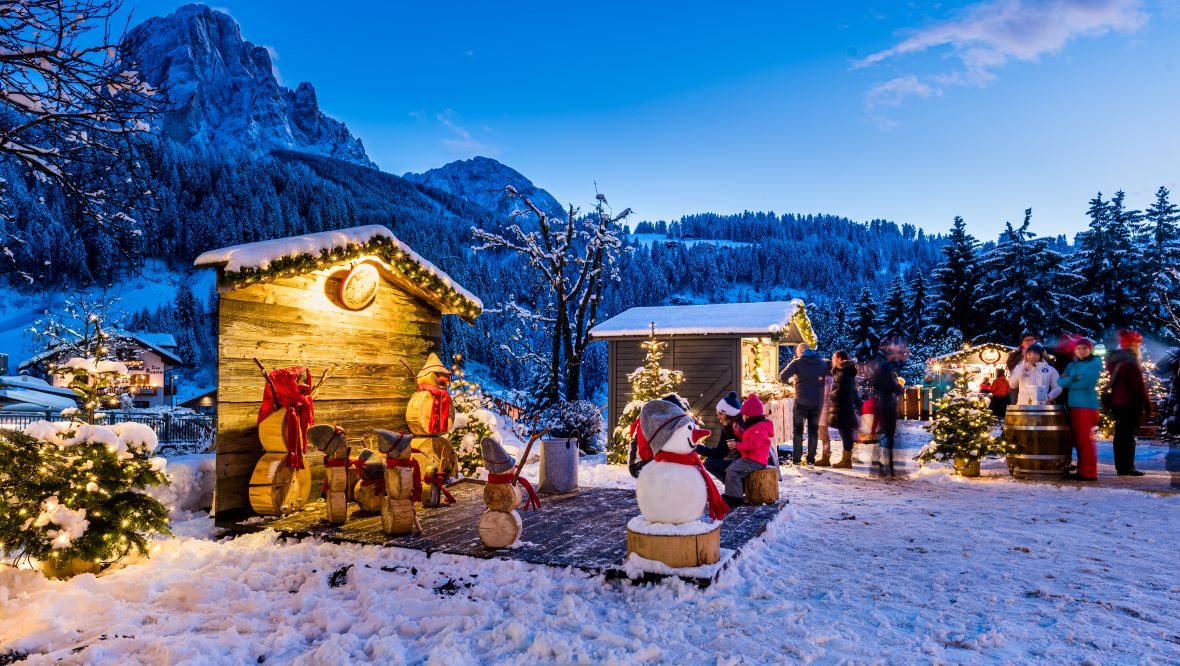
Sellaronda resorts like Santa Cristina are popular Christmas ski holiday destinations ©DOLOMITESValGardena
The Sellaronda’s artificial snow-making is particularly effective in mid-winter. Furthermore, the Sellaronda resorts are more likely to be sunny at this time of year than ski areas in the northern and western alps. And if you do get caught in a blizzard, there are lots of treelined slopes around the Sella Ronda where you can take shelter.
Consequently, the Sella Ronda often has some of the best piste skiing conditions in Europe in late December and January.
February and February-Half Term ski holidays to the Sellaronda
Throughout the Alps, February is usually the best time to get the right balance of deep, crisp snow underfoot and sunny blue skies overhead – and the Sellaronda is no exception.
The Sellaronda ski resorts are also less dependent on the UK market than most of the large ski resorts in the French Alps. Therefore, if you book direct, hoteliers and other accommodation providers are less likely to charge a massive premium for ski holidays during UK half-term week. It’s still a busy period for them, but it’s less of a peak within a peak than it is in more British-oriented ski resorts like Meribel or Val d’Isere.
Spring and Easter ski holidays to the Sellaronda
When winter turns to spring, and night-time temperatures stay above freezing, the Sellaronda ski resorts move heaven and earth (and a lot of snow) to keep the circuits skiable until the Sunday after Easter, but some of the lower outlying pistes close, and slush, ice and thin patches become much more common.
On the other hand, a lot of people like skiing the Sellaronda at this time of year. The snow might not be perfect, but the sunny terraces of the mountain huts are at their most appealing. And if you really want to do some hard skiing, you can always spend one day on the cold north-face of the Marmolada glacier in Arabba before returning to a more relaxing ski holiday.
The Best Sellaronda Ski Resorts
Selva (Val Gardena): Best for intermediate skiers.
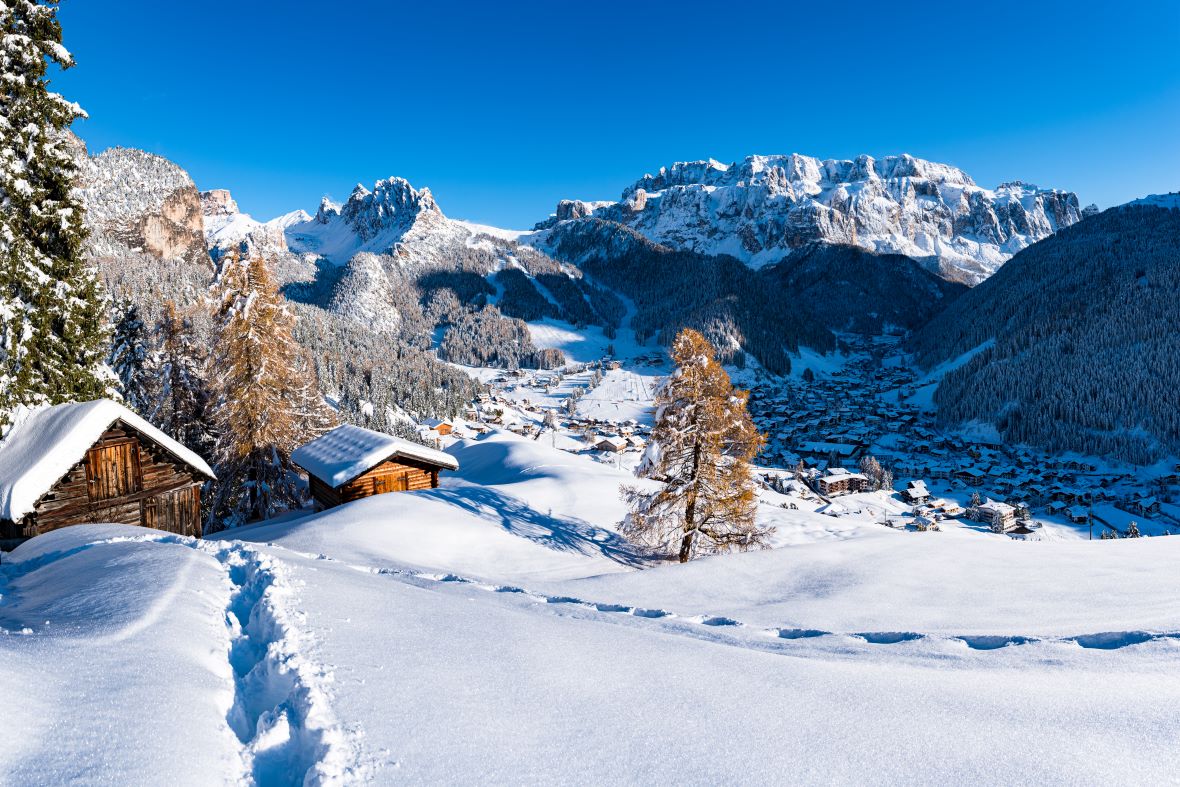
Selva is where Val Gardena meets the Sellaronda © DOLOMITESValgardena
The largest and most popular of the Sellaronda ski resorts, Selva is the T-junction where the Val Gardena valley (which is the biggest of the four ski areas) meets the Sellaronda circuits. Skiers based in Selva are therefore spoilt for choice when it comes to deciding where to ski but the local slopes around Selva are a good place to start because they are very intermediate-friendly. There are dozens of red and blue pistes, and confident intermediates should also try Val Gardena’s black runs: many are only slightly steeper than the surrounding reds.
More about Selva and Val Gardena >>>
Arabba (Arabba-Marmolada): Best for good skiers
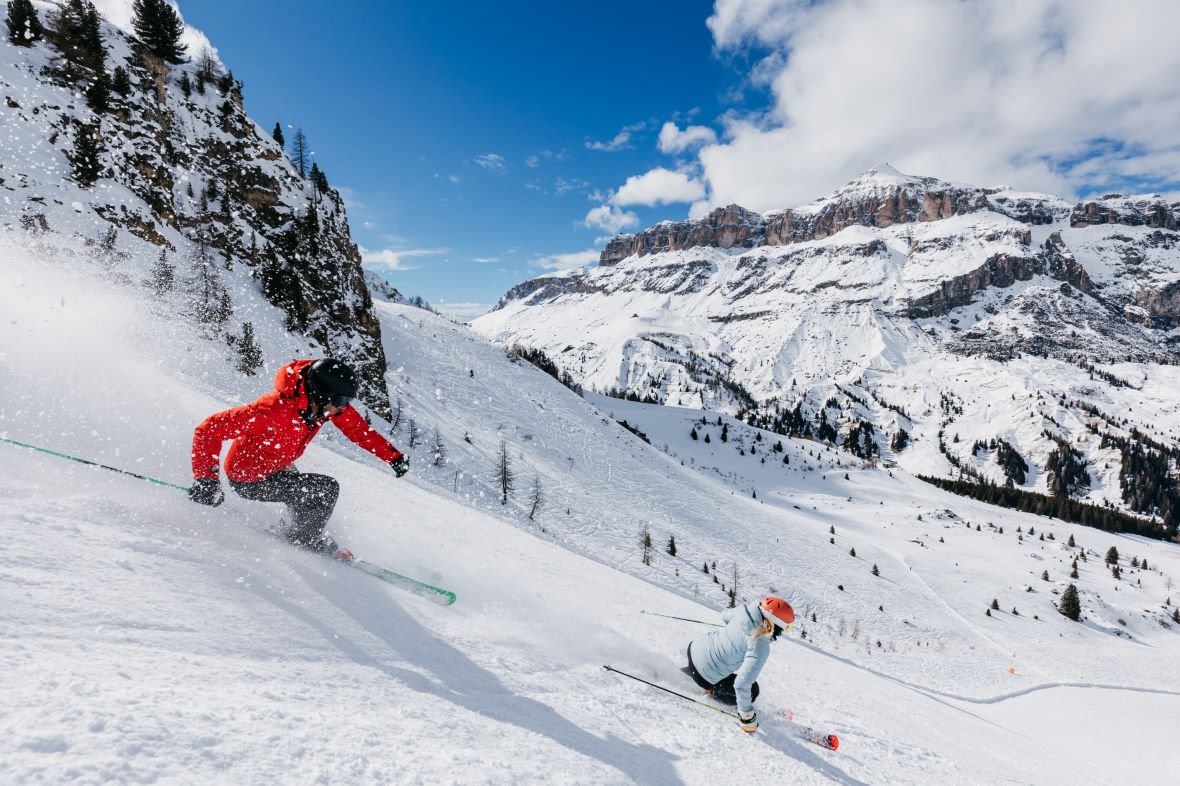
Arabba’s pistes are steeper than those in other Sellaronda resorts © Arabba Fodom Turismo
Arabba is a quiet mountain village, surrounded by steep mountains. The ski slopes immediately above it on Porta Vescovo are mostly challenging, north-facing, red and black runs – there are hardly any blue pistes at all. (This is no resort for beginners.) Behind Porta Vescovo is the snow sure Marmolada glacier where the top lift reaches 3,269m above sea level, giving access to a 12 km long red run. Arabba is also the closest resort to the 2,950m Sass Pordoi cable car just over the border in Val di Fassa, which is the starting point for most of the freeride and ski touring in the Sellaronda area.
Canazei (Val di Fassa): Best for charm.
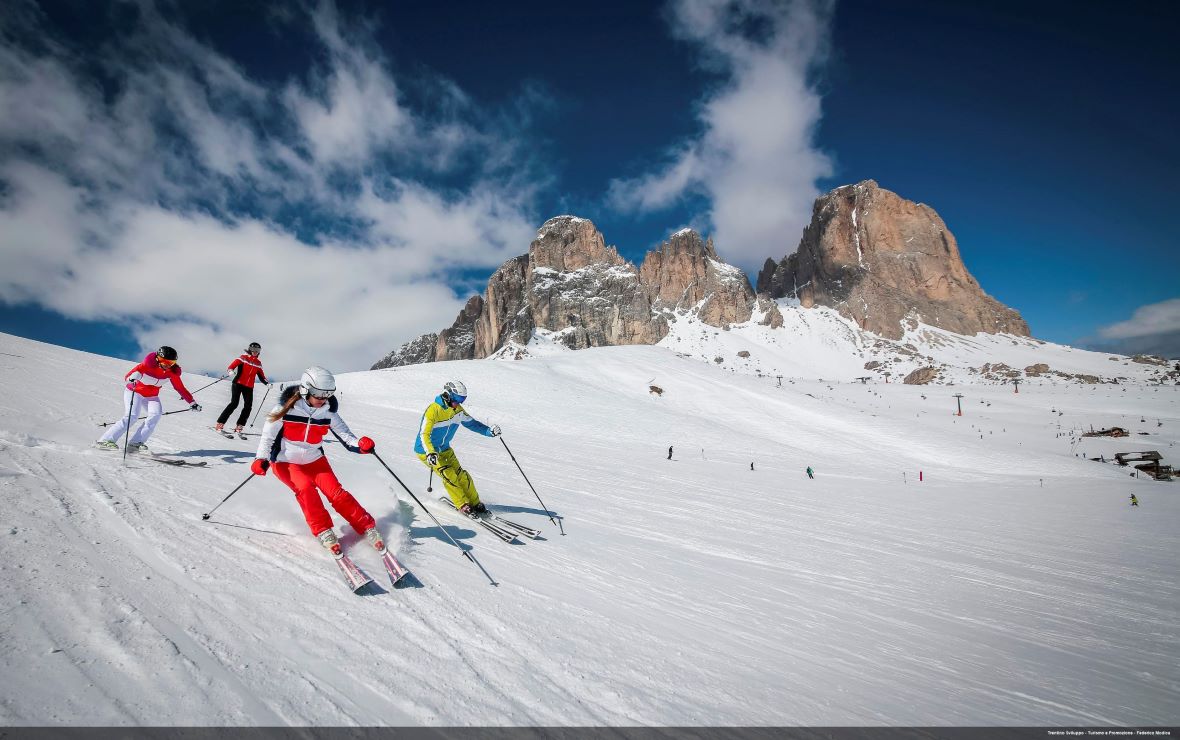
Col Rodella above Canazei in Val di Fassa © Trentino Sviluppo S.p.A – Federico Modica
Canazei is one lift below the clockwise and anticlockwise Sellaronda circuits and for aesthetes and romantics, its charms more than compensate for this slight inconvenience. An attractive Dolomite village, Canazei has outlying hamlets at Alba and Penia, but the central part has just enough restaurants, bars and cafes in its narrow streets to make it a nice place to spend time in without spoiling its traditional atmosphere. There is also an outdoor ice rink, a long cross-country ski circuit, good winter walks, and night skiing on the Aloch slopes at Media which is easy to reach by bus.
More about Canazei and Val di Fassa >>>
Santa Cristina (Val Gardena): Best for ski weekends and short breaks.
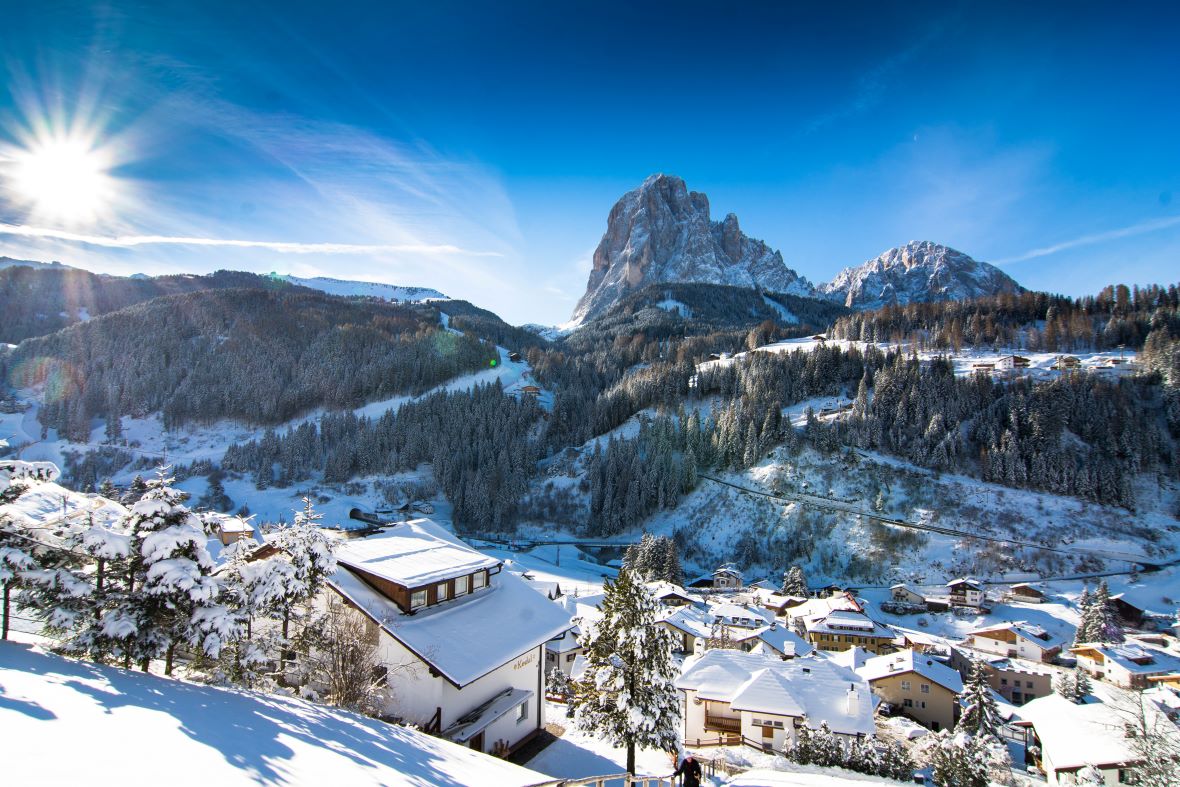
Santa Cristina in Val Gardena ©DOLOMITESValGardena
Of course, Santa Cristina is far more than just a good weekend ski resort. It’s a small, quiet, ski village with lovely views, located 5 km down the Val Gardena valley from Selva, with quick access to both Sellaronda circuits (they are only a couple of lifts away). But as a short-break holiday destination, Santa Cristina really excels. It’s quick and easy to get to: airport transfers from Innsbruck airport to Santa Cristina take less than two hours (Bolzano airport is even closer – transfers take just 45 minutes – but there are fewer flights.) And when you arrive in Santa Cristina, you are in the middle of the Val Gardena ski area which is the perfect size for 2 or 3 days’ skiing.
More about Santa Cristina and Val Gardena >>>
Corvara (Alta Badia): Best for beginners and nervous skiers
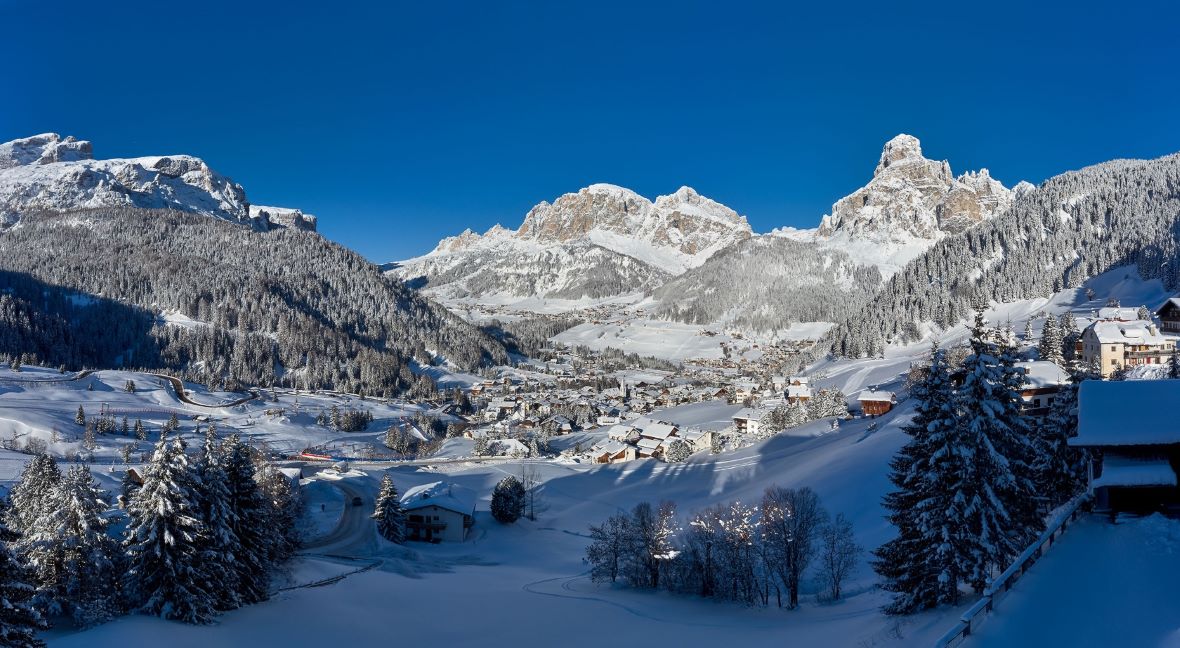
Corvara is on the Sellaronda circuit and surrounded by easy blue runs © Sporthotel Panorama Corvara
Corvara and its sister resort of Colfosco are on the Sellaronda circuits. They both have good nursery slopes at village level, so if a beginner needs a change of scene, it’s easy to swap locations via the two-way Borest gondola which runs between them. But what really sets Corvara apart is the maze of easy blue runs that beginners can progress onto which stretch out from the village eastwards towards La Villa, San Cassiano and Armentarola. This is true “blue run heaven”, enhanced by plenty of mountain restaurants. And should you grow bored of these slopes, there are more blue runs around Colfosco.
More about Corvara and Alta Badia >>>
Twelve of the best ski slopes on or near the Sellaronda
There are lots of easy blue pistes and short gentle red runs on the Sellaronda, so if that is what you like, just go out and ski the main circuit. But if you want something that is longer or more challenging, here are 12 slopes that justify a detour.
Saslong (Val Gardena) – Black slope
This is the famous 3.75km long, north-west facing Val Gardena FIS World Cup Downhill course but unless you come here on a race week, you don’t have to be able to ski at 70mph to enjoy it. Its official grade is black and its steepest parts reach 57%, but it also has easy sections where you can look around and admire the views. It starts off in the wide open meadows above Selva before plunging through the trees down to Santa Cristina, 830 vertical metres below.
Bellunese (Arabba-Marmolada) – Red slope
Marmolada, the Queen of the Dolomites, is a snowsure glacier that can be accessed from the Sella Ronda by skiing through Arabba and crossing the ridge behind it at Passo Padon, then continuing to the 3-stage cable car at Malga Ciapèla. From the top station at Punta Rocca at 3,269m, you ski down the north-facing red run Bellunese, although if you want to do the full 12km, 1,800m vertical metre descent, you also have to include the Padon (red) and Val d’Arei (blue) runs too which are less steep but very beautiful.
Gran Risa (Alta Badia) – Black slope
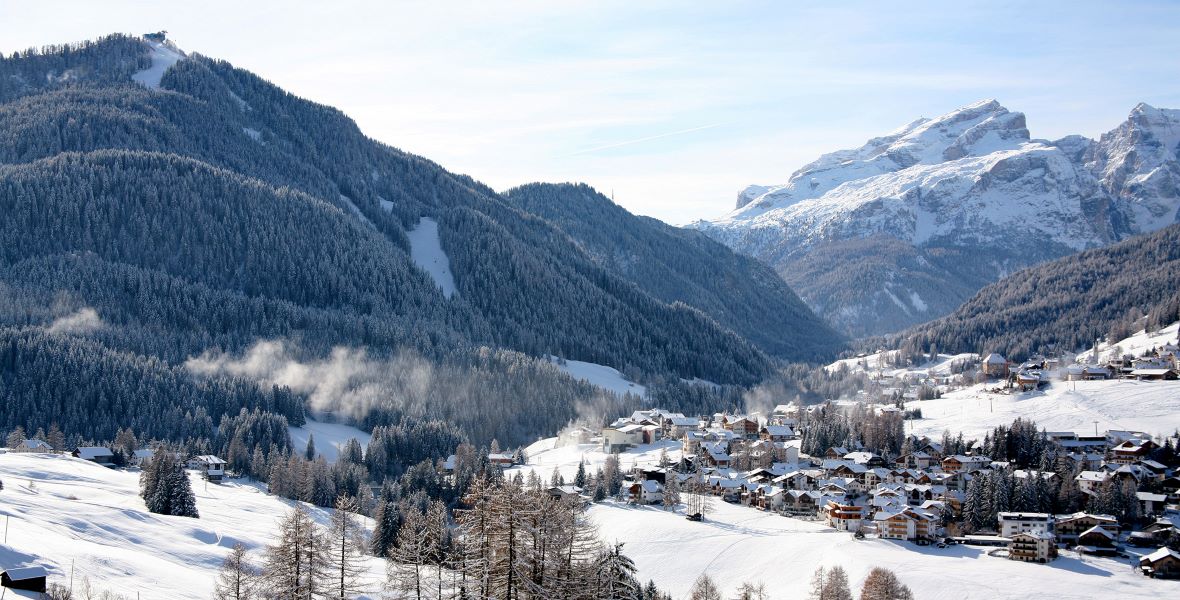
La Villa with Gran Risa black run in background © Alta Badia_Freddy Planinschek
Gran Risa is a relentlessly steep, north-facing, treelined black piste used for FIS World Cup Grand Slalom races. It starts on Piz La Ila above La Villa in Alta Badia. If you get into trouble at the start, you can bail out by crossing onto a red piste that peels off it after about 150 metres. But that’s your one and only parachute, and if you stay on the black piste, it gets steeper and narrower (and sometimes icier as well), reaching a maximum gradient of 69% before it flattens out at the very end.
Cir (Val Gardena) – Black slope
Cir starts at Dantercepies which is on the Green and Orange Sellaronda circuits above Selva. Cir, however, swerves away from Selva, ending up at the entrance to the beautiful Vallunga valley, famous for its sheer cliffs. Cir is 2.75 km long, with a vertical drop of 675 metres and is graded black, although in many resorts it would be a tough red.
3 Tre / 3 Tre Variente 1 ( Val di Fassa) – Red slope
This is a long red run with a vertical drop of about a 1,000m. It starts at Col Rodella in Val di Fassa, which is renowned for its scenic views and is just one chairlift away from both Sellaronda Circuits. The top section is north-facing, but you soon swing to the right onto 3 Tre Variente 1, heading eastwards to Pian Frataces. If snow conditions are good, keep going, turning onto the south-facing red run that continues down through the woods all the way to the pretty village of Canazei.
Ornella (Arabba-Marmolada) – Red slope
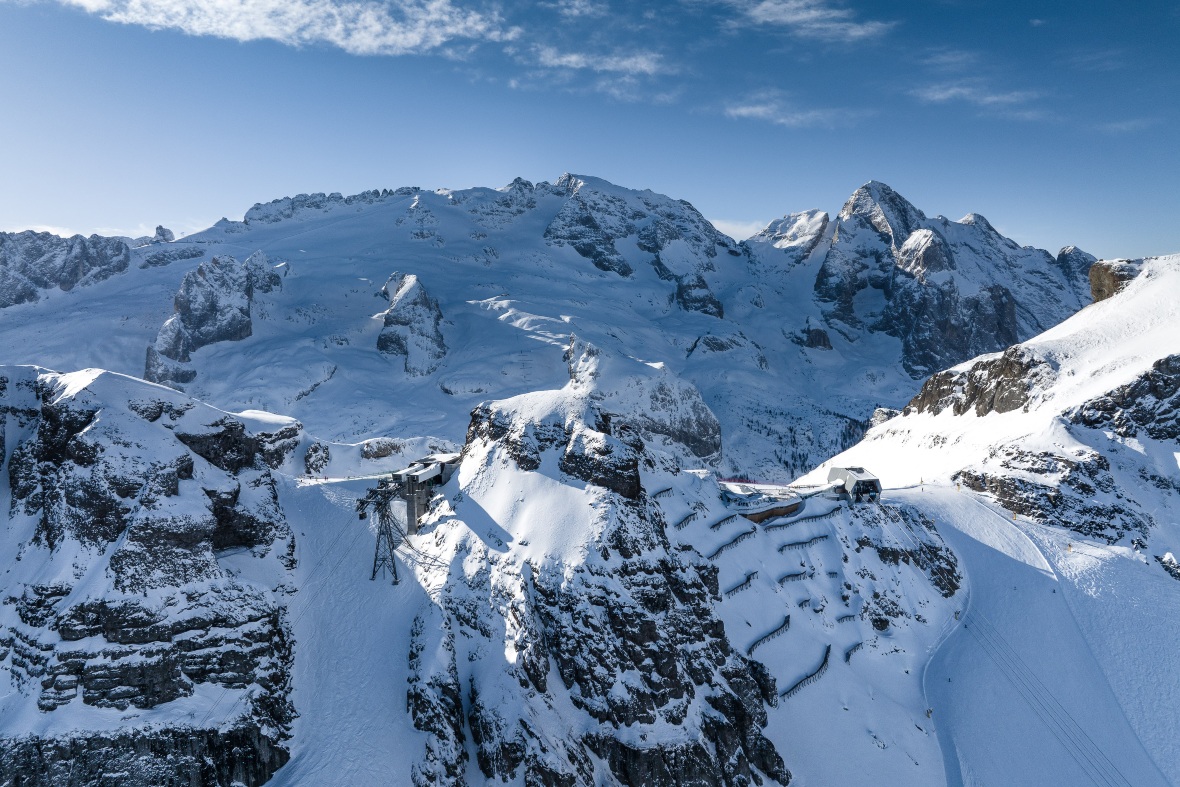
The top section of Ornella on the right of the photo is very steep for a red run © Matteo Agreiter Photography – Arabba Fodom Turismo
Ornella, a north-facing, top-to-bottom, red run with a vertical drop of about 900m, lies at the centre of Porta Vescovo, above Arabba. Take care, however, because it has a very steep section near the start, and nervous intermediates should skip this out by joining Ornella slightly lower down at the top of the Carpazza chairlift. From there on, Ornella is more beautiful than challenging as it meanders through rocky open mountain terrain then woods, but if you want another adrenalin rush, there are a couple of optional black variants near the end.
Vallon and Boé (Alta Badia) Black then Red slope
Boé is a red run that is on the clockwise Sellaronda circuit, between Arabba and Corvara. It can be enhanced, however, by combining it with Vallon, a black run (although not a steep one) immediately above it. Ski them both without stopping as one continuous slope to enjoy the contrast: Vallon is narrow, twisty and set in rocky terrain on an open mountainside, whilst Boé is mostly broad, straight and treelined. They are at their best early in the morning before the crowds arrive, but the combined descent has a vertical drop of about 1000m, so it’s quite a pipe-opener.
La Longia (Val Gardena) – Red slope
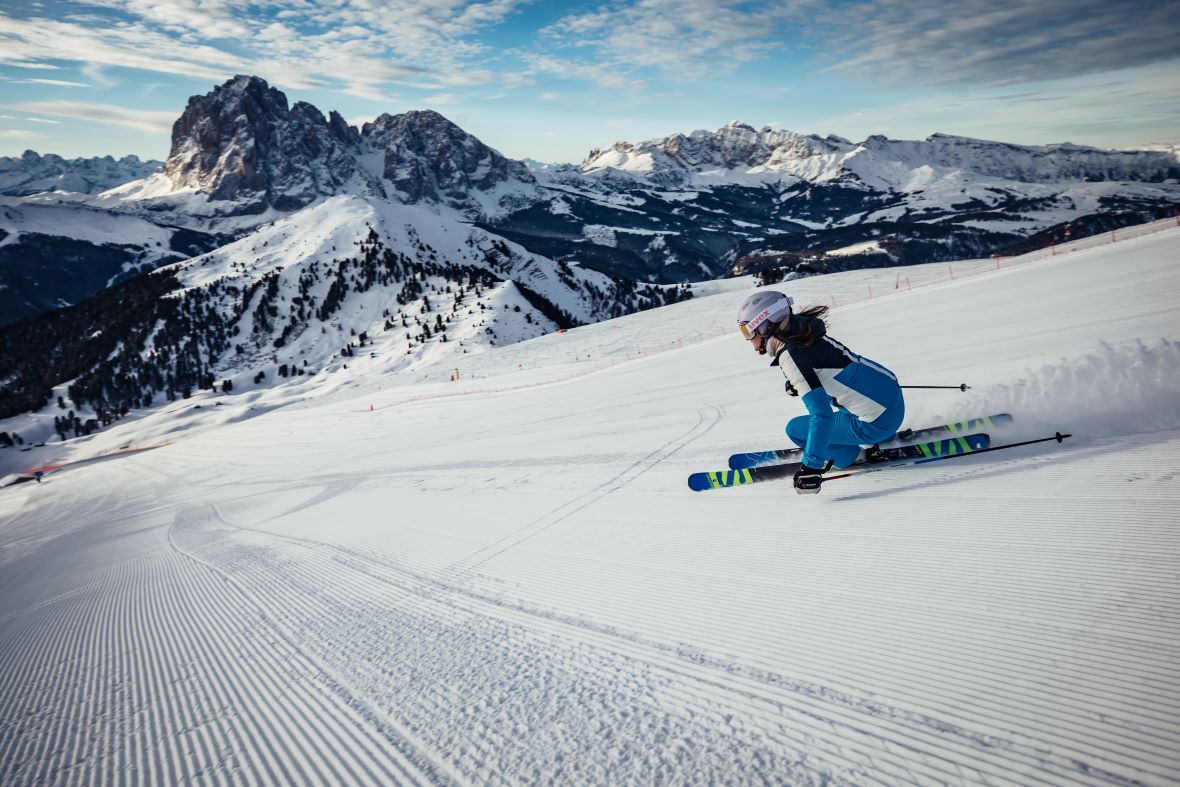
Skiing on Seceda above Santa Cristina in Val Gardena©DOLOMITESValGardena
At 10km long, La Longia is an accurately named, beautiful, scenic red run with a very unthreatening average gradient of 18%. It starts at 2,518m on the top of Seceda, the mountain on the far side of Santa Cristina if you’re coming from the Sellaronda, and after passing through an open bowl, rocky canyons and some woods, it finally ends in Ortisei, about 1,300m below. (There are four good mountain restaurants if you need refreshments en route.) From Ortisei, you can return to the top of Seceda by lift, where another long beautiful red run called Gardenissima takes you back towards Santa Cristina and the Sella Ronda.
Fodoma (Arabba-Marmolada) – Black slope
Fodoma is a north-facing, 2.8 km long, black run with an average gradient of 30 %, although in one section it reaches 56%, which is enough to grab anyone’s attention, even though the surrounding scenery is spectacular. Fodoma branches off the Ornella red run on Porta Vescovo above Arabba, so it’s only one lift away from both Sellaronda circuits, and well worth the journey just by itself. But it also has a sister run, called Sourasass (“the black pearl”) which is longer but slightly less steep, and strong keen skiers should really try to ski them both before returning to the easy red and blue runs that are the mainstays of the Sellaronda circuits.
Ciampinoi N. 3 (Val Gardena) – Black slope
Sometimes called the ‘Technical Slope’, this north-east facing black piste has hosted Men and Women’s Giant Slalom races. It starts at the top of the Ciampinoi gondola above Selva on the same mountainside as the Saslong downhill course (see above) but whereas that heads towards Santa Cristina, Number 3 stays closer to the Sellaronda circuits, heading back through the trees to Selva, and finishing next to the gondola base station. Its total length is about 2.4km, with a vertical drop of about 680m.
Lagazuoi-Armentarola (Cortina d’Ampezzo/Alta Badia) – Red slope
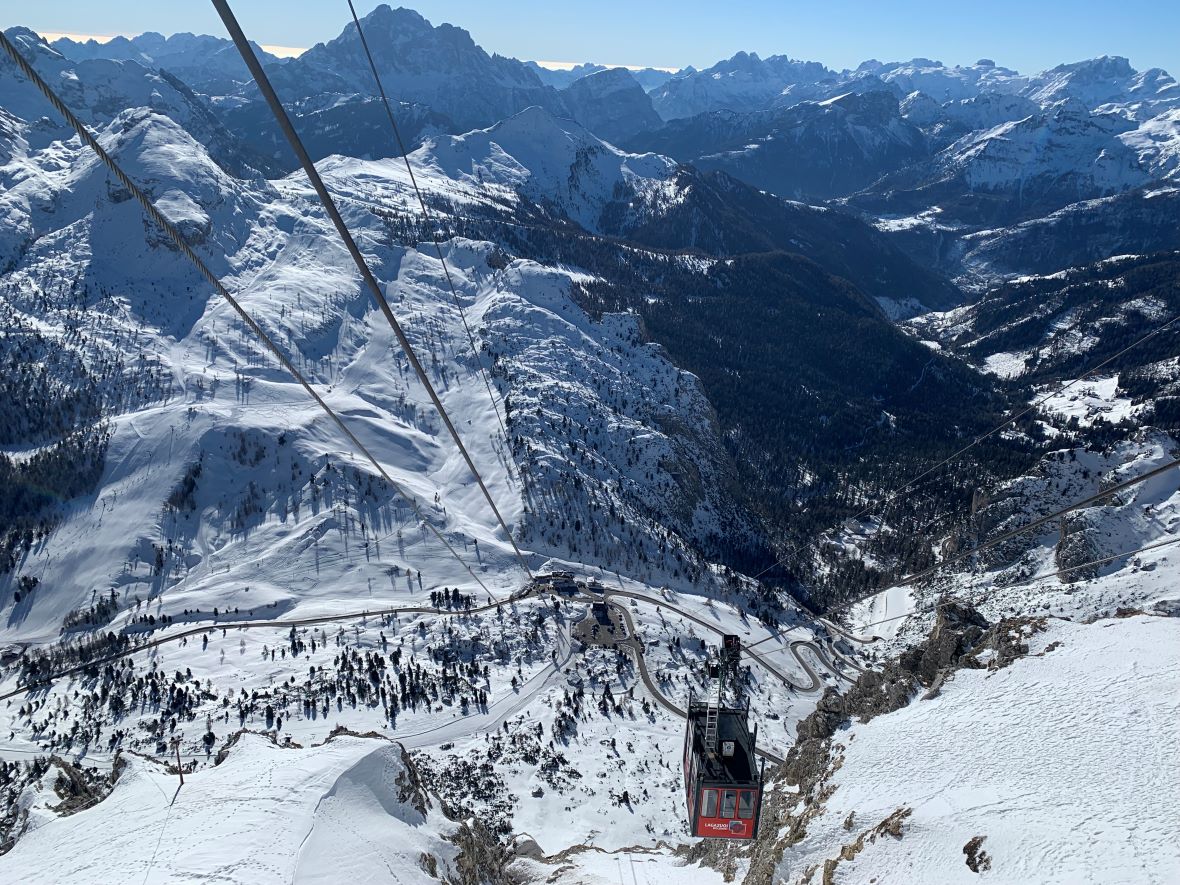
Lagazuoi cable car at Passo Falzarego
Lagazuoi-Armentarola, or ‘Hidden Valley’, is the ski slope that takes you back to Alta Badia from Cortina d’Ampezzo. It’s a relatively gentle red run, famous for its Dolomite scenery, that’s quite far from the Sellaronda circuit, but worth the effort. First, you have to ski down to the small hamlet of Armentarola near San Cassiano in Alta Badia; then take a shared taxi to the spectacular Passo Falzarego cable car. The Lagazuoi-Armentarola slope starts at the top station and finishes over 7km later back in Armentarola. The vertical drop is over 1,100m, but towards the end, it becomes almost flat, so it’s best to complete the final section being towed behind specially trained horses. This ‘lift’ is not included in any ski-pass but it’s cheaper than a taxi (and more dangerous, so concentrate).
Val Mezdí (Val di Fassa/Alta Badia) – Freeride/Ski-Touring Route
The Sellaronda is not a great destination for freeriders and ski tourers but it does have one excellent off-piste itinerary, the Val Mezdí, which cuts straight through the middle of the Sella massif. It starts at the top of the Sass Pordoi cable car at 2,950m which is in Val di Fassa but close to Arabba, and ends in the meadows near the Frara piste close to Colfosco in Alta Badia. It usually requires skins because there is a short climb of just over 100m near the start to get over Col Turond. You are strongly advised to take an off-piste mountain guide with you.
Further information about the Sellaronda Ski Resorts
For more details about the ski areas, villages, accommodation, ski hire, ski lessons and how to get there, please see:
Ultimate-Ski Guide to Val Gardena >>>
Ultimate-Ski Guide Alta Badia >>>
Ultimate-Ski Guide to Arabba-Marmolada >>>
Ultimate-Ski Guide to Val di Fassa >>>
Author: William Micklethwait











